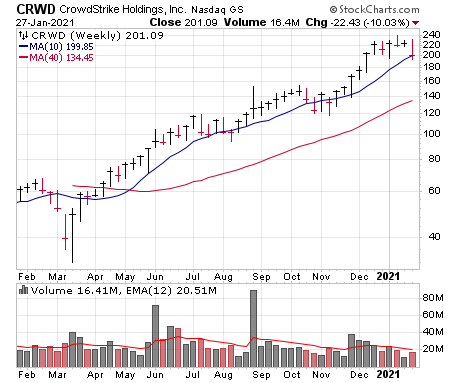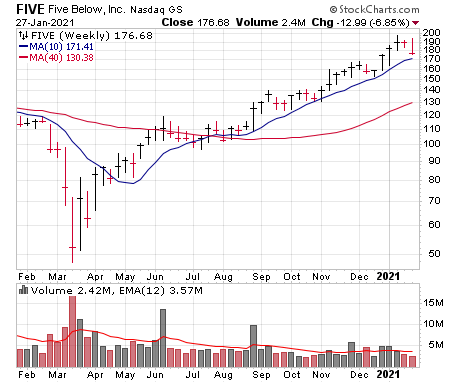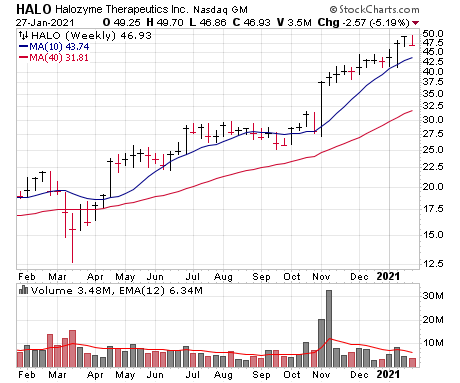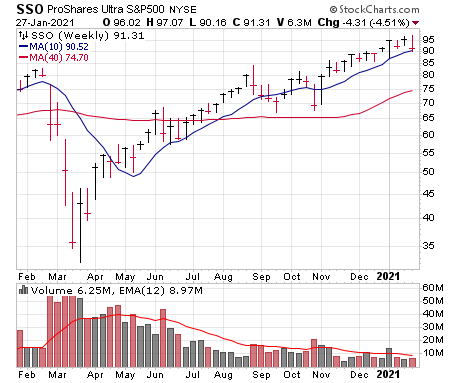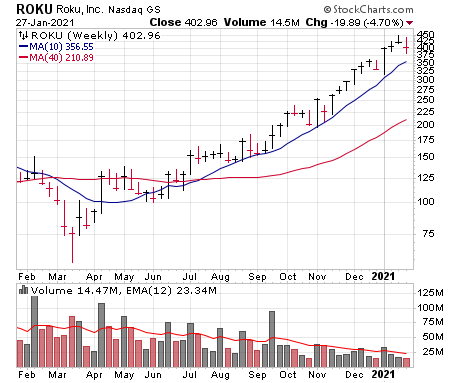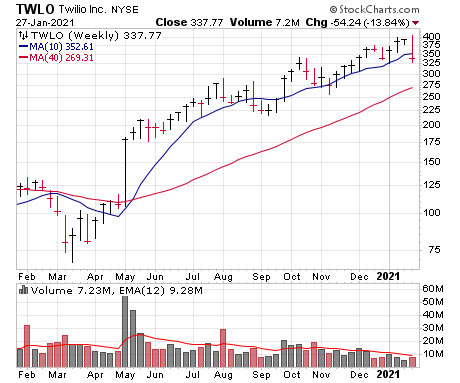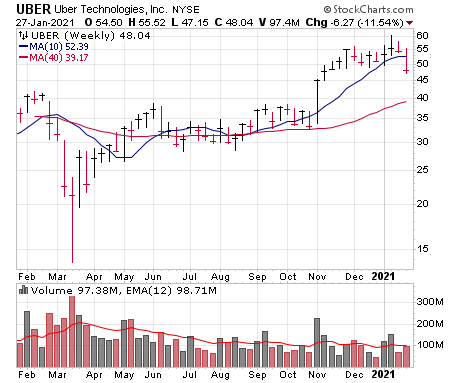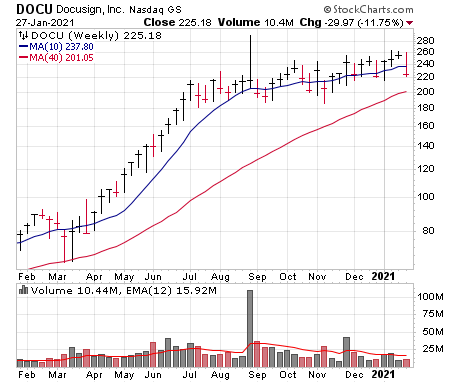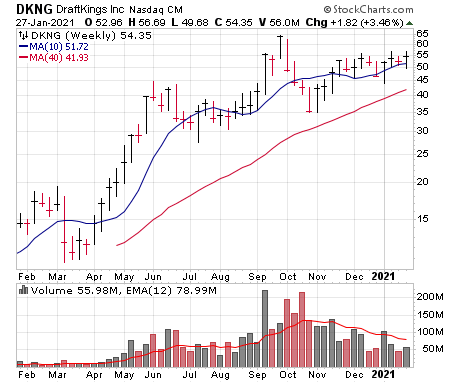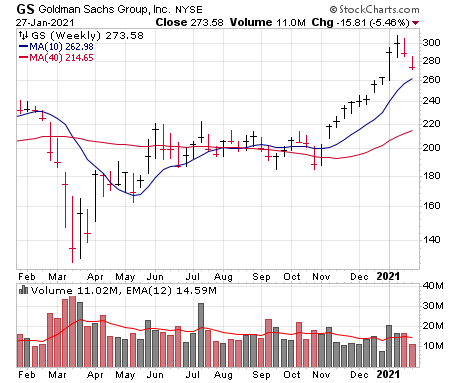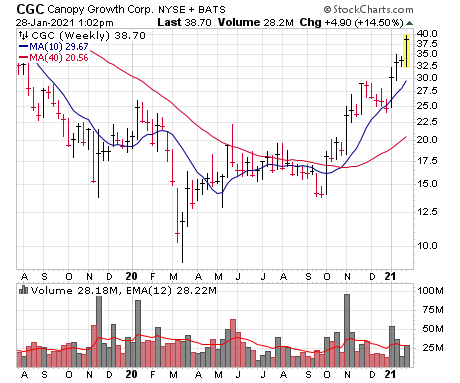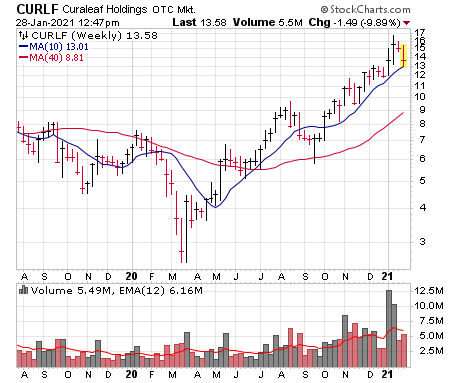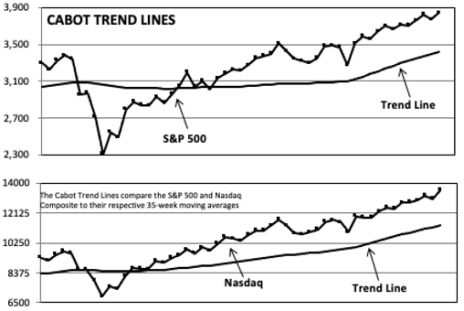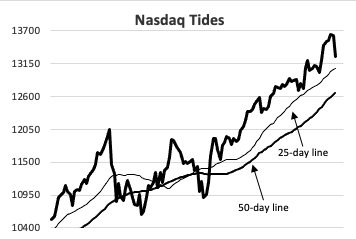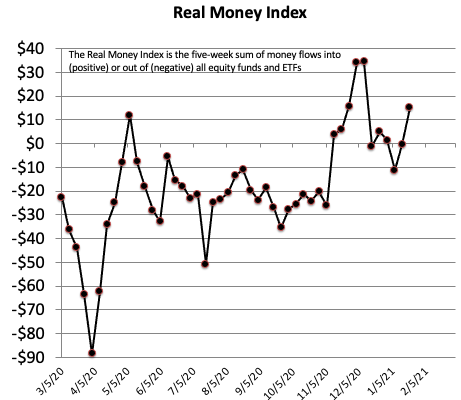Risk has been rising for a while, and this week, we’ve seen some wild action along with some abnormal selling. That said, we haven’t seen a rash of breakdowns, either, so we’re moving gradually--we pared back some earlier this week, leaving us with 27% in cash, but we’re also willing to give our stocks a bit of rope as we wait to see how this plays out. As always, we’re flexible when looking ahead, and are willing to put money to work if this morphs into yet another shakeout, or pare back further if the sellers stay at it.
In tonight’s issue, we go over all our stocks in depth, write a piece about the marijuana industry and talk about a couple of intriguing individual stocks that have been setting up for months and could be ready to go if the market can find support.
Cabot Growth Investor 1464
[premium_html_toc post_id="224489"]
Unexpected Events Occur Frequently
One of the unique things about the market (and a big reason so many investors have trouble) is that it doesn’t follow the usual “bell curve” of probabilities that dominates the real world. For instance, given that the market’s average return is 8% to 10% annually, you’d think that most years would finish somewhere in that range, give or take a few percent. But it turns out two-thirds of all market years deliver either a loss or a gain of more than 20%.
More broadly, the simple reality is that, in the market, so-called unexpected events—those that statistics would tell you happen once every 15 or 20 years—actually occur relatively frequently (every two to four years). We’re seeing yet another “never before seen” event occur over the past week, as a handful of highly shorted names have gone vertical, so much so that some hedge funds are taking on water, which in turn has likely led them to dump their winners—causing strong growth stocks to get nailed!
We have a couple of thoughts, the first of which is: Don’t be like those hedge funds that refused to hedge (ironic, right?) or cut losses, allowing one or two big, bad trades to ruin their year (or their business). You want to do the opposite—always cut losses short so that one or two big winners can really power your portfolio ahead.
Our second thought is to simply go with the evidence—when volatility picks up, so do the number of predictions and explanations, but usually, it’s better to stick with the facts.
With that in mind, the evidence shows a lot of stocks that came into this week extended in both time (been running for months) and price (huge runs, above moving averages, etc.) have seen some abnormal selling, which isn’t good. That said, the evidence also shows the major indexes still in uptrends, and many key leaders are holding support (50-day lines, etc.), with some very encouraging bounces today.
In this sort of scenario (damage done and some legitimate yellow flags, but no knockout blow yet to the market or many leaders), we’ve found it best to take some action to respect what’s going on … but also to avoid all-or-nothing moves.
What To Do Now
That’s what we’ve done this week, taking partial profits on three names (Five Below, Pinterest and Roku) while placing a tight stop on our weakest stock (Uber). We now have 27% in cash and are keeping an open mind (buying or selling) depending on what happens from here.
Model Portfolio Update
While the start of the year was solid for growth stocks, we’re now seeing more than a few signs of weakness. Thankfully, as things were hot and heavy, we didn’t do much buying recently—our only buy during the past month was filling out our position in HALO (still holding very well) and we paired that with a partial sell of ROKU a couple of weeks ago.
But there’s no question that the speculative fervor going on in the market is something that usually occurs late in a move, backing up the view that risk is rising—combine that with some iffy action among growth stocks of late (not just selling off this week, but many stalled out the prior couple of weeks), we’ve pared back.
On yesterday’s special bulletin, we trimmed FIVE, PINS and ROKU, boosting our cash position to around 27%. As always, we remain flexible—we’re keeping our watch list up to date should this prove to be a dramatic shakeout, but if the sellers continue to dig in, we’re open to raising more cash.
Current Recommendations
| Stock | No. of Shares | Portfolio Weightings | Price Bought | Date Bought | Price on 1/28/21 | Profit | Rating |
| CrowdStrike (CRWD) | 567 | 5% | 175 | 12/11/20 | 213 | 22% | Buy a Half |
| Five Below (FIVE) | 852 | 7% | 138 | 9/18/20 | 179 | 30% | Hold |
| Halozyme (HALO) | 4,639 | 10% | 44 | 11/27/20 | 48 | 9% | Buy |
| Novocure (NVCR) | 1,335 | 10% | 142 | 11/6/20 | 161 | 14% | Buy |
| Pinterest (PINS) | 2,222 | 7% | 40 | 9/18/20 | 69 | 72% | Hold |
| ProShares Ultra S&P 500 (SSO) | 1,741 | 8% | 60 | 5/29/20 | 93 | 55% | Buy |
| Roku (ROKU) | 451 | 8% | 205 | 8/28/20 | 404 | 97% | Hold |
| Twilio (TWLO) | 553 | 9% | 174 | 5/8/20 | 362 | 108% | Hold |
| Uber (UBER) | 3,656 | 9% | 52 | 11/20/20 | 52 | 0% | Hold |
| CASH | $583,552 | 27% |
CrowdStrike (CRWD)—CRWD got off to a great start for us, but thankfully we held off averaging up as the stock quickly became extended on the upside—and we’ve seen the result this week, with a big air pocket (down more than 30 points in less than three days!) before finding solid support. Despite the nauseating drop, we actually think the stock looks decent here—it tagged (and held) its 10-week line during Wednesday morning’s fall, and volume has been much lower than the three big buying weeks in December. Throw in a growth story that has years of runway ahead of it (and a chart that only decisively got going from a big IPO base last August) and we continue to see CRWD as relatively rare merchandise that big investors will accumulate for a long time to come. Frankly, if the stock (and growth stocks as a whole) can stabilize, we wouldn’t be opposed to filling out our position soon, but we’ll see how it goes. If you don’t own any, we’re OK starting a half position here and using a reasonable (12% or so) loss limit. BUY A HALF.
Five Below (FIVE)—We decided to ring the register yesterday morning on Five Below, selling one-third of our position and holding the rest. As we’ve written before, the odds strongly favor the stock having more upside down the road due to its best-in-class fundamentals (15% to 20% new store growth annually; new openings recouping 90% of opening costs within the first year of operation; accelerating same-store growth in Q4 and January, etc.) and an early-stage chart (two-year base breakout last September). But having run without any pullback for five months, FIVE got out of trend on the upside earlier this month and, sure enough, is now wobbling a bit. We’ll follow our usual tack—with a decent partial profit in the bank, we’re aiming to hold through any near-term correction that develops and play out FIVE for what ideally will be a larger longer-term gain. HOLD.
Halozyme (HALO)—Despite the hectic action seen across the market, HALO has been cool as a cucumber, holding tightly just south of round number resistance near 50. And why shouldn’t it? Given the stock’s rapid and reliable growth profile (not to mention a reasonable valuation at 28 times this year’s earnings estimate), we think this is the type of name where the number of institutional owners (543 funds at year-end) could mushroom as the growth story gets out. Of course, none of this is to say HALO can’t get caught up in any further market weakness, but the longer it remains resilient, the greater the chance that it heads nicely higher down the road. We’ll stay on Buy, though we’d suggest starting small up here or trying to nab shares on dips of a couple of points. BUY.
Novocure (NVCR)—NVCR has pulled back a fair amount of late (180 to 160, round numbers), but looks normal on the chart—selling volume has been tame and the stock has thus far held its 50-day line. Given that we had a 20%-plus profit on our combined cost basis (just under 142), we have rules to avoid letting that turn into any meaningful loss, which means we’ll be using a mental stop in the 140 area (which is also the top of its prior range) as a worse-case. Right now, though, we’re keeping our optimist’s hat on—Q4 sales have already been pre-announced, and many on Wall Street are coming around to the view that Novocure is likely to get approval for new indications in the years ahead that could expand its addressable market by 10-fold or more. We’re not complacent, but with the stock acting normally, we’ll stick with our Buy rating. BUY.
Pinterest (PINS)—We decided to trim our Pinterest position a bit in yesterday’s special bulletin (selling one-fourth of our remaining shares), as the combination of the souring growth stock environment along with this stock’s own action (no progress for many weeks, lots of sloppy action lately) told us the buyers were losing power—and indeed, on Wednesday, the stock gapped below its 50-day line. Thinking about some potential scenarios, one (bullish) possibility is that this sharp shakeout is what PINS needed to get rid of the weak hands and pave the way for its next upmove. Still, we need to see that to believe it—until some strong buying appears, it looks like PINS needs more time to consolidate its massive prior move (40 to 75) from September through mid-December. A big key will obviously be earnings, which are due out in a couple of weeks (February 4). In the meantime, we’re content to hold the rest of our position with a loose stop (somewhere in the low 50s for now). HOLD.
ProShares Ultra S&P 500 Fund (SSO)—There’s no question we’re seeing some abnormal action for the first time in a while, both on the sell side (some growth leaders cracking intermediate-term support) and buy side (wild upmoves in heavily-shorted stocks). Still, the major indexes are still in fine shape—SSO tagged all-time highs as recently as Tuesday! A crack of the 50-day line (around 89-90) could have us moving to Hold, but we’re trend followers at heart, and there’s no question the trend of the S&P 500 (and all other major indexes) continues to point up. If you don’t own any, we’re OK taking a swing at SSO here with a reasonable loss limit. BUY.
Roku (ROKU)—Partially because it was still our largest position (more than 11% of the portfolio), we decided to trim a few more shares of ROKU on our special bulletin yesterday, selling one-fourth of our remaining shares. Interestingly, the stock found some support yesterday right at its 25-day line (closed nearly unchanged on a horrid market day), so ideally this latest sale will turn out to be a mistake. Fundamentally, the firm continues to make progress solidifying its leadership position—Roku inked a deal with Amazon to bring that firm’s ad-supported IMDb TV service to its platform, and while IMDb competes with Roku’s streaming channel, Roku usually takes a 30% cut of ad sales on partners’ channels, so it’ll win either way. Back to the stock, it remains strong, but also is very extended, so we’re handling it similarly to PINS—happy to hold what we own with a loose stop, but we’d look elsewhere for new buys at the moment. HOLD.
Twilio (TWLO)—TWLO has come down with most other growth stocks, and admittedly, it looks worse on its chart than others—moving from a clear new high Monday morning to below its 50-day line two days later (before bouncing) doesn’t usually portend good things. To be clear, it’s not a disaster: Another good day or two could brighten the picture, and nothing has changed our big-picture view that Twilio is an emerging blue-chip name that institutions will support over time. Still, we’re not in the business of ignoring abnormal action—we’ll switch to a Hold rating and see how TWLO handles itself following this recent selling wave. HOLD.
Uber (UBER)—Two weeks ago Uber looked about as good as can be, but things have changed—it began with some wobbles after Softbank started to unload some shares, and the selling accelerated during the market’s latest wobbles, with shares briefly diving to two-month lows yesterday before today’s strong, encouraging snapback. Overall, UBER’s dramatic year-long breakout (which was a big reason we bought in the first place) is very much intact, so we’ll give shares a chance to find their footing, though with a cost basis just above 51, so we don’t want to absorb too much of a loss. We advise holding, but we also have a relatively tight mental stop (47 to 48 area) in the case the selling continues. HOLD.
Watch List
- Canopy Growth (CGC 40): There aren’t many liquid marijuana plays, but CGC is one, and any opening of U.S. markets will only accelerate growth. See more later in this issue.
- Farfetch (FTCH 61): Following its doubling in just two months, FTCH’s recent 18% slide is far from abnormal. We still think this has the looks of a new leader.
- Floor & Décor (FND 94): FND has been tossed around this week, but we’re willing to watch it and see if this is a shakeout vs. a breakdown.
- Teladoc (TDOC 264): TDOC has broken out impressively on the upside, though it has dipped with most names during the past few days. If it can find support soon, it could set up a new, higher-odds entry point.
Other Stocks of Interest
DocuSign (DOCU 235)—Right now we’re most interested in either (a) looking for strong names that are making their first pullback (usually a higher-odds setup), or (b) identifying some big winners from early last year that have worn out the weak hands for many months and look ready to resume their advance. That could be the case with DocuSign, a name we rode to great profits last year, and the story and numbers are better than ever—the company is the hands-down leader in e-signatures, which save firms and users tons of time and money, and DocuSign’s broader “Agreement Cloud,” which involves digitizing all processes of agreements (automatic document production, etc.) is gaining steam. The idea simply makes sense, and the company was growing quickly (revenues up in the high 30% range) for years and the pandemic accelerated that as everything went mobile (sales up 45% and 53% the past two quarters, with earnings taking off and sub-metrics looking outstanding). Analysts see earnings rising another 50% this year, which is almost surely too low. Of course, the market looks ahead, which is why DOCU made such a huge move in the first half of last year—the blowoff top in early September caused us to sell our remaining shares, and the huge downside volume that appeared there almost always caps a stock for months … which is exactly what happened here. But the weekly chart has avoided distribution since that iceberg—all the big-volume weeks have either been support (shakeout in early November) or strong buying (late November). DOCU has wobbled this week and might need some more seasoning, but any decisive show of strength could be the signal that the next sustained advance has begun.
DraftKings (DKNG 56)—We still think online sports betting and so-called iGaming (online casino-type gambling) are at the front edge of a multi-year growth cycle—greater convenience will certainly attract a lot of bettors, and the need for states to recoup revenue in the wake of the pandemic means more legalization efforts are on the way. DraftKings is one of the leaders in the field (Penn National is the other thanks to its stake in the Barstool app) due to its brand name and rapid expansion efforts; we like it because it was effectively built from the ground up for this movement. And the progress it’s making is impressive—in October, it launched its mobile sportsbook in Tennessee, in December it inked a deal with Foxwoods Casino to eventually launch an online sportsbook once Connecticut gives the go-ahead, and just this month the company has launched mobile sports betting in Virginia and an online sportsbook and iGaming offering in Michigan. (This doesn’t take into account numbers of partnerships with specific franchises like the New York Giants that make DraftKings their preferred sports betting provider.) Even so, DraftKings is only up and running in 12 states, so the potential is enormous going forward—encouragingly, the firm has been able to crank out tons of revenue ($550 million expected in 2020) despite the fact the industry is just getting going and Covid held back sports schedules during the year. Management is already on record forecasting 45% revenue growth this year, which we think could prove conservative as the sports world goes back to normal and new markets officially open for business. DKNG had a monster run early last year, but since the start of June it’s been building a base-on-base formation, with one deep structure (June-August) leading to another deep consolidation (October-January). Net-net, the stock made no progress for seven months, allowing stronger hands to move in (414 funds owned shares at year-end, up from 248 six months before). We think the next major move is up, though like many names, DKNG could need a bit more time. Either way, it’s worth keeping an eye on. Earnings are due February 26.
Goldman Sachs (GS 276)—Goldman Sachs isn’t going to take your portfolio to the promised land, and it’s obviously not a true growth stock, instead riding the ups and downs of the investment world. Yet in my webinar last week, I actually picked GS as one of my three top stocks for 2021! Why? The main reason involves the group—we’ve always been fans of Bull Market stocks, meaning firms whose business is directly tied to the health of the overall market. Yet this “sector” was dead in the water from the start of 2018 through October of last year ... but now it’s staged a longer-term breakout. And GS actually lagged that sorry performance—as of October, the stock hadn’t made any net progress in 13 years! However, business has been solid (earnings have jaggedly advanced in recent years from around $20 per share in 2018 to north of $27 last year), and analysts see that continuing (last two quarters saw the bottom line up 87% and 158%), which, like many financial and cyclical stocks, has created a dirt-cheap valuation (10 times earnings, 1.7% dividend yield). However, what’s really changed of late is investor perception—the entire group staged massive long-term breakouts late last year, with GS leading the way, powering to new highs and rising 11 straight weeks, a serious sign of institutional accumulation in such a liquid name as this. Now the stock is pulling back; maybe it will take a while to digest the recent move, but we think GS remains the favorite Bull Market stock for the big-money crowd, and the breakout-and-follow-through action bodes very well for the months ahead. Again, this won’t be the fastest horse or biggest winner, but the odds are strong that a sustained, longer-term uptrend has begun.
Marijuana Stocks: Big Potential, Little Liquidity
No matter what you think of marijuana on a personal basis, it’s likely early in what should be a massive growth phase, partly due to top-down factors (new leadership in Washington, D.C. and a desire for more revenue from the states). Investment-wise, it’s effectively an entirely new industry—and our studies have shown firms from new sectors (XM Satellite was the best example) can be superb winners.
For marijuana, the tough part is the vast majority of opportunities just don’t have enough liquidity for our tastes—we obviously don’t need a stock to be traded in the Dow or S&P to consider it, but if you’re a lower-priced stock trading very little volume, the odds of being able to hold on through a sustained advance is remote as the stock is sure to get tossed around by news, rumors and crosscurrents.
For our part, Canopy Growth (CGC) is probably the most straightforward way to play the marijuana sector. This Canadian company has its hands in a bunch of different cannabis cookie jars—it’s gaining share in the Canadian recreational market (more than 15% share in weed and more than 40% share in beverages), is the leader in Germany’s medical marijuana market and is a player in the U.S., partially thanks to a series of CBD products (gummies, soft gels and oils) that are co-branded with Martha Stewart.
And management is very bullish on its ability to penetrate the U.S. further as legalization efforts succeed, especially thanks to beverage giant Constellation Brands, which owns 38% of Canopy and is sure to be a key player in distribution as things open up. Revenues boomed 77% in Q3 and there’s little doubt the company is going to get a lot bigger over time. As for the stock, CGC went through the wringer in 2019 and most of 2020, but it’s been very strong since November and gained steam so far this year.
If you don’t mind dabbling in a thinner name, one that we like is Curaleaf (CURLF), which is the largest U.S. cannabis company as measured by revenue—in fact, it’s probably the firm most levered to increased legalization in the U.S. Partially thanks to acquisitions, including that of Grassroots last year, Curaleaf is up and running in 23 states, with a top 3 market share in most of them thanks to nearly 100 retail locations (set to expand to 135 in the near future) and a good wholesale business (distributed to 1,300-plus locations).
All in, the company has served more than two million patients in the medical cannabis market (medical sales tend to be steadier and more reliable), and it’s also involved in many adult-use states, with the recent legalization in Arizona and New Jersey likely to goose sales going forward. Revenues have been growing at triple-digit rates, EBITDA is solidly positive (earnings are around breakeven) and the stock is one of the few in its sector to have hit all-time highs during this latest surge.
There are other names to consider as well (GrowGeneration (GRWG) is a neat cookie-cutter and roll-up story), but our main thought is that if the potential upside in weed is as big as we think it is, more big investors will get involved and create more opportunities. For now, we’re keeping an eye on CGC and seeing if CURLF can “grow up” in terms of sponsorship.
Market Outlook: Short Term vs Long Term
Short term, we’re seeing more yellow flags out there; indeed, maybe this week’s growth stock action could be the start of that. We don’t anticipate these things, but we also don’t leave our brain at the door—it’s clear risk is elevated, so we’re OK holding some cash and pruning further if we have to.
However, should the market correct, the odds strongly favor that dip being a short- to intermediate-term event. The reason: We continue to see truly unusual (and bullish) readings from broad market measures. One that we touched on last summer is the running average of the percent of stocks hitting new lows (a variation of our old Two-Second Indicator). Specifically, during the past 50 trading sessions on the Nasdaq, less than 0.5% of issues (on average) have been hitting new lows. Even including a similar reading last summer, that’s just the 10th time it’s occurred since 1982.
Interestingly, the market did hit some indigestion about half the time during the next three months, but looking out a year, the risk/reward was actually quite bullish—the Nasdaq advanced a max of 27% sometime during the following 12 months, while its maximum loss from the signal was under 5%.
Beyond the specific numbers, though, is the fact that major tops rarely occur when everything is strong—that can precede a correction for sure (hence our current don’t-push-it mentality), but tops almost always come around when there’s been some degradation in the broad market. We’re not seeing that now, which bodes well when looking months down the road.
Cabot Market Timing Indicators
Cabot Trend Lines: Bullish
Many times in the market, it’s hardest to keep things simplest, with many getting caught up in the wild action and headlines (like this week). Our Cabot Trend Lines filter that out, focusing on the longer-term trend, which remains strongly positive—even after Wednesday’s drop, the S&P 500 (by 9%) and Nasdaq (by 15%) remained well above their respective 35-week lines, telling us the overall bull market remains intact.
Cabot Tides: Bullish
Our Cabot Tides are also in bullish territory, though they bear a bit more watching—many indexes (including the Nasdaq, daily chart shown here) are well above their lower (50-day) moving averages, though a couple (like the NYSE Composite) actually tagged their 50-day lines yesterday before today’s rebound. Either way, we just go with what’s in front of us; despite the dramatic action, both the intermediate- and longer-term trends of the market are pointed up.
Cabot Real Money Index: Neutral
Our Real Money Index has perked back up a bit as money continues to flow slowly but steadily into the market, a marked change from the past couple of years. What we’re most interested in is seeing how the average Joe reacts to this week’s shenanigans—a week or two of huge outflows could be a sign this will prove to be more of a shakeout than a sustained decline. We’ll be watching.
Charts courtesy of StockCharts.com
The next Cabot Growth Investor issue will be published on February 11, 2021.
Cabot Wealth Network
Publishing independent investment advice since 1970.
President & CEO: Ed Coburn
Chairman & Chief Investment Strategist: Timothy Lutts
176 North Street, PO Box 2049, Salem, MA 01970 USA
800-326-8826 | support@cabotwealth.com | CabotWealth.com
Copyright © 2021. All rights reserved. Copying or electronic transmission of this information is a violation of copyright law. For the protection of our subscribers, copyright violations will result in immediate termination of all subscriptions without refund. No Conflicts: Cabot Wealth Network exists to serve you, our readers. We derive 100% of our revenue, or close to it, from selling subscriptions to its publications. Neither Cabot Wealth Network nor our employees are compensated in any way by the companies whose stocks we recommend or providers of associated financial services. Disclaimer: Sources of information are believed to be reliable but they are not guaranteed to be complete or error-free. Recommendations, opinions or suggestions are given with the understanding that subscribers acting on information assume all risks involved. Buy/Sell Recommendations: All recommendations are made in regular issues or email alerts or updates and posted on the private subscriber web page. Performance: The performance of this portfolio is determined using the midpoint of the high and low on the day following the recommendation. Cabot’s policy is to sell any stock that shows a loss of 20% in a bull market or 15% in a bear market from the original purchase price, calculated using the current closing price. Subscribers should apply loss limits based on their own personal purchase prices.

